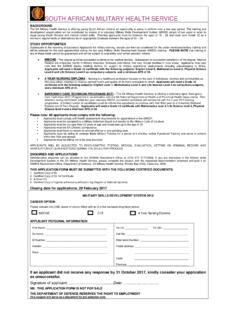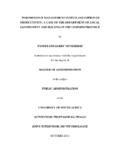Transcription of Defence in a Democracy - SANDF
1 Defence in a DemocracyWhite paper on National Defence for the Republicof South AfricaMay 1996 TABLE OF CONTENTSD rafting MemorandumForewordChapter 1: IntroductionAim and ScopeProcessChapter 2: The Challenge of TransformationNational Security Policy and the RDPD efence in a DemocracyInternational Law on Armed ConflictChapter 3: Civil-Military RelationsConstitutional ProvisionsAuthority and PowersDefence IntelligenceThe Department of DefenceMilitary ProfessionalismEducation and TrainingResponsibilities of GovernmentRights and Duties of Military PersonnelRelations with civil societyChapter 4: The Strategic EnvironmentThe Global ContextThe Regional ContextThe Domestic ContextWhite paper on Defencefile:///A|/ white paper on (1 of 37) [11/23/1999 9:30:55 AM]Chapter 5: Role and FunctionsConstitutional ProvisionsSelf-DefenceDeployment in Co-operation with the SA Police ServiceInternational Peace Support OperationsOther Defence FunctionsChapter 6: Human Resource IssuesIntegrationAll-Volunteer ForcePart-Time ForceDemobilisation and RationalisationEqual Opportunity and Affirmative ActionDefence Labour RelationsChapter 7: Budgetary ConsiderationsChapter 8: Arms Control and the Defence IndustryDefence IndustryPrinciples Governing Conventional Arms TradeArms Control Process and StructuresInternational Arms Control Regimes and TreatiesChapter 9.
2 Land and Environmental IssuesLandEnvironmentDRAFTING MEMORANDUMD rafting historyThe 21 June 1995 draft of this document was published by the Minister of Defence with an invitation toParliament and the public to comment 27 October 1995 draft incorporated comments submitted by political parties, non- governmentalorganisations, the Defence industry, Defence analysts, and members of the public and the 31 January 1996 draft incorporated proposals from the Joint Standing Committee on Defence (JSCD), as approved by that committee on 23 January 30 March 1996 draft incorporated the Minister's decisions regarding proposals of the JSCD andfurther submissions from the Department of paper on Defencefile:///A|/ white paper on (2 of 37) [11/23/1999 9:30:55 AM]The 22 April 1996 draft incorporated further comments of the JSCD and the Portfolio Committee onDefence, and was presented to Cabinet on 8 May document presents, for the consideration of Parliament, the Minister's white paper on Defence asapproved by Cabinet with certain new ConstitutionThis document draws extensively on the Interim Constitution.
3 In the light of the adoption of the newConstitution by Parliament on 8 May 1996, references to the Constitution in the white paper will beamended content of the white paper will not be affected materially, however, since the new Constitutionincorporates, as transitional arrangements with the force of law, the relevant provisions on Defence in theInterim gives me great pleasure and pride to present the government's white paper on National Defence for theRepublic of South South Africa's first democratic election in April 1994, the South African National DefenceForce ( SANDF ) was established through the integration of former statutory and non-statutory integration of these forces, many of which were once enemies-in-arms, Is a powerful symbol andpractical demonstration of our country's commitment to national reconciliation and as the establishment of the SANDF represents the unity of military formations, so this white Paperreflects a national consensus on Defence white paper is the culmination of a lengthy process of consultation following the tabling of a firstdraft in Parliament on 21 June received many responses to that draft; we engaged in a lively debate to accommodate and reconcilethese responses; and we were enriched, in particular, by the significant contributions of the JointStanding Committee on Defence and the Portfolio Committee on is therefore no exaggeration to say that this white paper is a historic document.
4 For the first time in ourhistory, Defence policy has been shaped by substantial inputs from Parliament, members of the public,non-governmental organisations and, of course, the Department of the first time in our history, a white paper on Defence reflects the interests of our people andrepresents a national consensus on this critical function of ModiseMINISTER OF DEFENCE8 May 1996 white paper on Defencefile:///A|/ white paper on (3 of 37) [11/23/1999 9:30:55 AM]CHAPTER 1: INTRODUCTION1. This white paper has been prepared in the spirit of the new democratic era in South Africa. Itacknowledges, as its point of departure, the profound political and strategic consequences of the endingof Following free and fair elections in April 1994, South Africa has become a vibrant Democracy . It has aConstitution which outlaws discrimination, enshrines fundamental rights, and emphasises openness andaccountability in the affairs of The Constitution also establishes a framework for democratic civil-military relations.
5 In terms of thisframework the Defence Force is non-partisan; it is subject to the control and oversight of the duly electedand appointed civilian authority; and it is obliged to perform its functions in accordance with After two and a half decades of isolation, South Africa has been welcomed back into the internationalcommunity and has joined a host of important regional and international bodies. The country's foreignrelations have been transformed from an adversarial mode to bilateral and multi-lateral This fundamental shift has been accompanied by a dramatic change in the strategic environment atdomestic and regional levels. While the potential for instability and conflict remains, the salient fact isthat the government is no longer unrepresentative and at war with its own people and neighbouring statesin Southern The government has prioritised the daunting task of addressing poverty and the socio-economicinequalities resulting from the system of apartheid.
6 The Reconstruction and Development Programme(RDP) stands at the pinnacle of national policy and, consequently, Defence The government is equally committed to national reconciliation and unity. One of the most dramaticillustrations of this commitment is the integration of the former statutory and non-statutory forces intothe South African National Defence Force ( SANDF ).8. The white paper addresses the implications of these momentous developments for Defence policy andthe and scope9. The white paper presents the Defence policy of the Government of National Unity following a processof consultation with Parliament and the public. Its principal purpose is to inform citizens and other states,particularly those in Africa, of South Africa's new Defence policy. The white paper is also intended toserve as a confidence- and security-building measure in Southern Defence policy should be in harmony with all other aspects of government policy, particularlyforeign policy and national security policy.
7 It can be described as that subset of government policy whichis concerned with countering military threats; with the orientation, preparation, maintenance andemployment of armed forces; and with the procurement of weaponry and military Accordingly, the white paper considers the following The overarching challenge of transforming Defence policy and the armed forces in the contextWhite paper on Defencefile:///A|/ white paper on (4 of 37) [11/23/1999 9:30:55 AM]of the Constitution, national security policy, the RDP, and international law on armed conflict.[Chapter 2] Civil-military relations, with reference to the constitutional provisions on Defence ;transparency and freedom of information; Defence intelligence; the structure of the Department ofDefence (DOD); military professionalism; civic education; the responsibilities of governmenttowards the SANDF ; and the rights and duties of military personnel.
8 [Chapter 3] The external and internal strategic environment and the importance of promoting regionalsecurity. [Chapter 4] The primary and secondary functions of the SANDF . [Chapter 5] Human resource issues, including integration; the maintenance of an all-volunteer force; thePart-Time Force; rationalisation and demobilisation; equal opportunity, affirmative action,non-discrimination and gender relations; and Defence labour relations. [Chapter 6] Budgetary considerations. [Chapter 7] Arms control and the Defence industry. [Chapter 8] Land and environmental issues. [Chapter 9]Process12. The Minister of Defence is committed to on-going consultation with Parliament, political parties,interest groups, non-governmental organisations and citizens in order to forge a national consensus onmilitary There are several reasons for this shift in emphasis. First, accountability, responsiveness andopenness in government are now constitutional tenetsSecond, the SANDF is a national institution which relies on public support and public funds to fulfil itsmandate.
9 Third, the functions and orientation of the SANDF are necessarily matters of great On 21 June 1995 the Minister published a draft white paper on Defence with an invitation to citizensand their elected representatives to comment thereon. Over ninety written submissions were received,and the parliamentary Joint Standing Committee on Defence held three special sessions on the and proposals have been scrutinised carefully and, to the greatest extent possible,incorporated into this The submissions and parliamentary deliberations were characterised by substantial support for theprocess of consultation, the content of the 21 June draft and the Minister's intention to effect afundamental transformation of Defence A common concern was the absence of detail in many areas. While this matter has been addressed, itshould be emphasised that the white paper seeks to establish a broad policy framework and the mainprinciples of Defence in our new paper on Defencefile:///A|/ white paper on (5 of 37) [11/23/1999 9:30:55 AM]17.
10 The white paper will provide the basis for a Defence Review which elaborates on this framework inconsiderable detail. The Review will entail comprehensive long-range planning on such matters asdoctrine, posture, force design, force levels, logistic support, armaments, equipment, human resourcesand Members of the Joint Standing Committee on Defence and civilian experts will participate inconducting the Review. A first draft will be published for parliamentary and public comment and willcontain options with respect to the size, roles and structure of the SANDF . The final product will bepresented to Further, the Minister will submit to Parliament detailed proposals on important matters such asdemobilisation and rationalisation; equal opportunity and affirmative action; military education andtraining; the Part-Time Force; and weapons acquisitions In addition to the presentation of annual budgets for parliamentary approval, the Minister will submitto Parliament annual Defence 2: THE CHALLENGE OF TRANSFORMATIONN ational security policy and the RDP1.
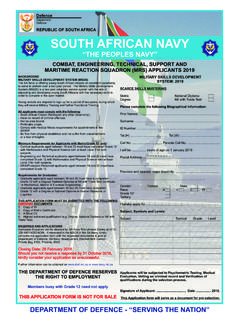
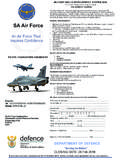
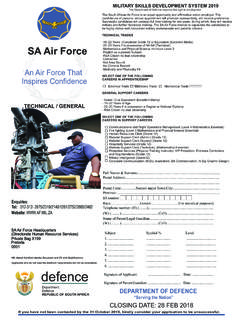
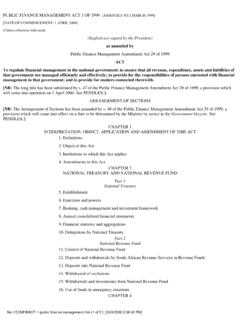
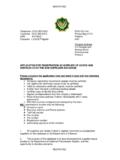
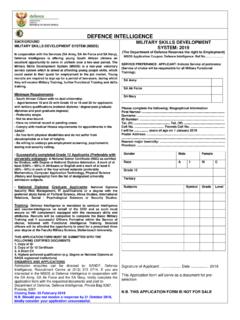

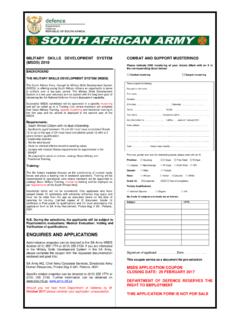
![[a42y2002]DEFENCE ACT 42 OF 2002](/cache/preview/4/8/f/0/8/f/6/c/thumb-48f08f6ca7f1fb0dc9c37b3eb3dc705b.jpg)
